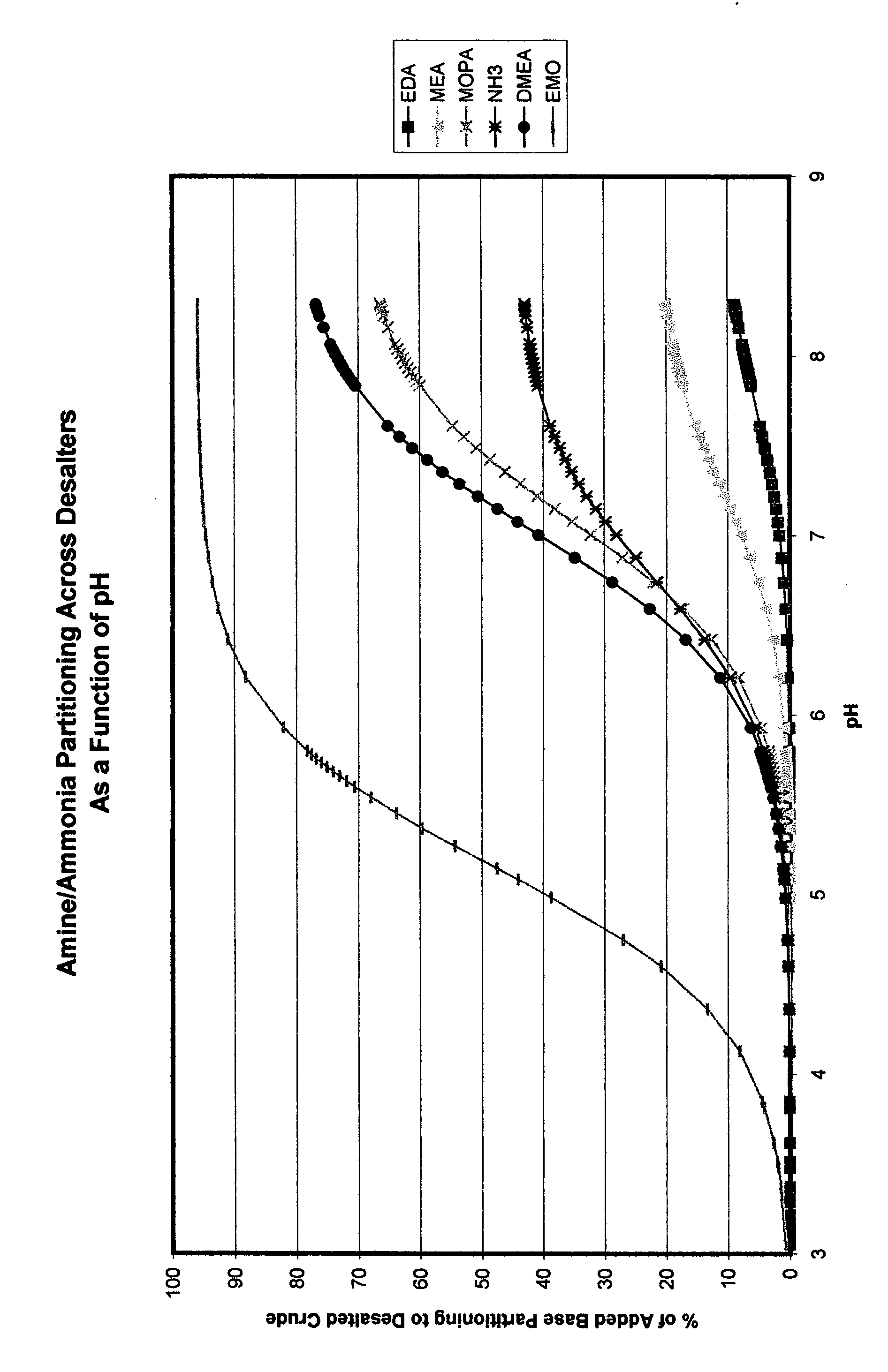Additives to enhance phosphorus compound removal in refinery desalting processes
a technology of phosphorus compound and additives, which is applied in the direction of water treatment, separation process, and other chemical processes, can solve the problems of rag layer inside the desalter vessel growing to such an extent, oil and water emulsions that are difficult to resolve, and complicated desalting process of particulate solids
- Summary
- Abstract
- Description
- Claims
- Application Information
AI Technical Summary
Benefits of technology
Problems solved by technology
Method used
Image
Examples
examples 84-110
[0086] Examples 84-110 were conducted using the same EDDA Test Method and analytical method described above. All of the tests were conducted on the same sample of crude oil. This sample of western Canadian crude oil was from a refinery experiencing severing fouling with phosphorus-based deposits. The EDDA tests were run at 100° C. for all of the tests and 5.5% wash water was used in each test. After the crude oil was treated and processed in the EDDA, the effluent water was collected and sent for analysis to determine the ion content in solution by ICP. The oil samples were ashed using microwave digestion and the resulting aqueous solution was analyzed by ICP. The various compositions tested are given in Table VII.
TABLE VIIAdditiveCompositionAdditive G98% glycolic acid (70%) 2% Magna 240 corrosion inhibitoravailable from Baker PetroliteAdditive H95% gluconic acid 5% citric acidAdditive J95% glycolic acid 4% thioglycolic acidBlend XBlend of non-ionic emulsion breakersavailable from...
examples 84-93
[0087] In these Examples, all samples were processed in the EDDA to simulate a desalting process. The first sample, Example 84, had no emulsion breaker of acid added, but was desalted. The rest of the samples except the wash water (Example 93) were treated with metals removal chemistry in addition to an emulsion breaker to help resolve the emulsion. In this study, Additive G at 20 ppm (Example 85) and in the other Examples 86, 89 and 90 effectively removed Ca and Fe from the crude oil. The treatment also reduced P content by about 25%.
TABLE VIIIEx.Sample Identification84Raw crude (Blank sample)85Treat at 20 ppm of Additive G, Desalter crude86Treat at 30 ppm of Additive G, Desalter crude87Treat at 30 ppm of Additive H, Desalter crude88Treat at 30 ppm of Additive J, Desalter crude89Treat at 20 ppm of Additive G, Effluent water90Treat at 30 ppm of Additive G, Effluent water91Treat at 30 ppm of Additive H, Effluent water92Treat at 30 ppm of Additive J, Effluent water93Wash water
[0088]...
example 94-95
[0089] In these Examples it may be seen that only 10 ppm of Additive G was required to remove most of the Ca and Fe. Again, the P seems to be reduced by about 25%.
TABLE XEx.Sample Identification94Treat with Blend X @ 10 ppm-vAdditive G @ 100 ppm-vWash water rate 5.5%Mix ΔP = 12 psigEffluent water95Treat with Blend Y @ 10 ppm-vAdditive G @ 100 ppm-vWash water rate 5.5%Mix ΔP = 12 psigDesalter crude
[0090]
TABLE XIICP EDDA Test Results (ppm - wt / wt), Examples 94-95Ex.NaKMgCaMoFeCuZnAl94146060.669.143376.32.88.71.8950.41.21.42.00.8Ex.BaBeCdCrPbMnNiB940.20.40.90.32.0950.53.11.3Ex.SrSiPSTiVSn949.34.24.8365952.83.0NR6.50.5
NR = Not run
PUM
| Property | Measurement | Unit |
|---|---|---|
| temperature | aaaaa | aaaaa |
| temperatures | aaaaa | aaaaa |
| total volume | aaaaa | aaaaa |
Abstract
Description
Claims
Application Information
 Login to View More
Login to View More - R&D
- Intellectual Property
- Life Sciences
- Materials
- Tech Scout
- Unparalleled Data Quality
- Higher Quality Content
- 60% Fewer Hallucinations
Browse by: Latest US Patents, China's latest patents, Technical Efficacy Thesaurus, Application Domain, Technology Topic, Popular Technical Reports.
© 2025 PatSnap. All rights reserved.Legal|Privacy policy|Modern Slavery Act Transparency Statement|Sitemap|About US| Contact US: help@patsnap.com



